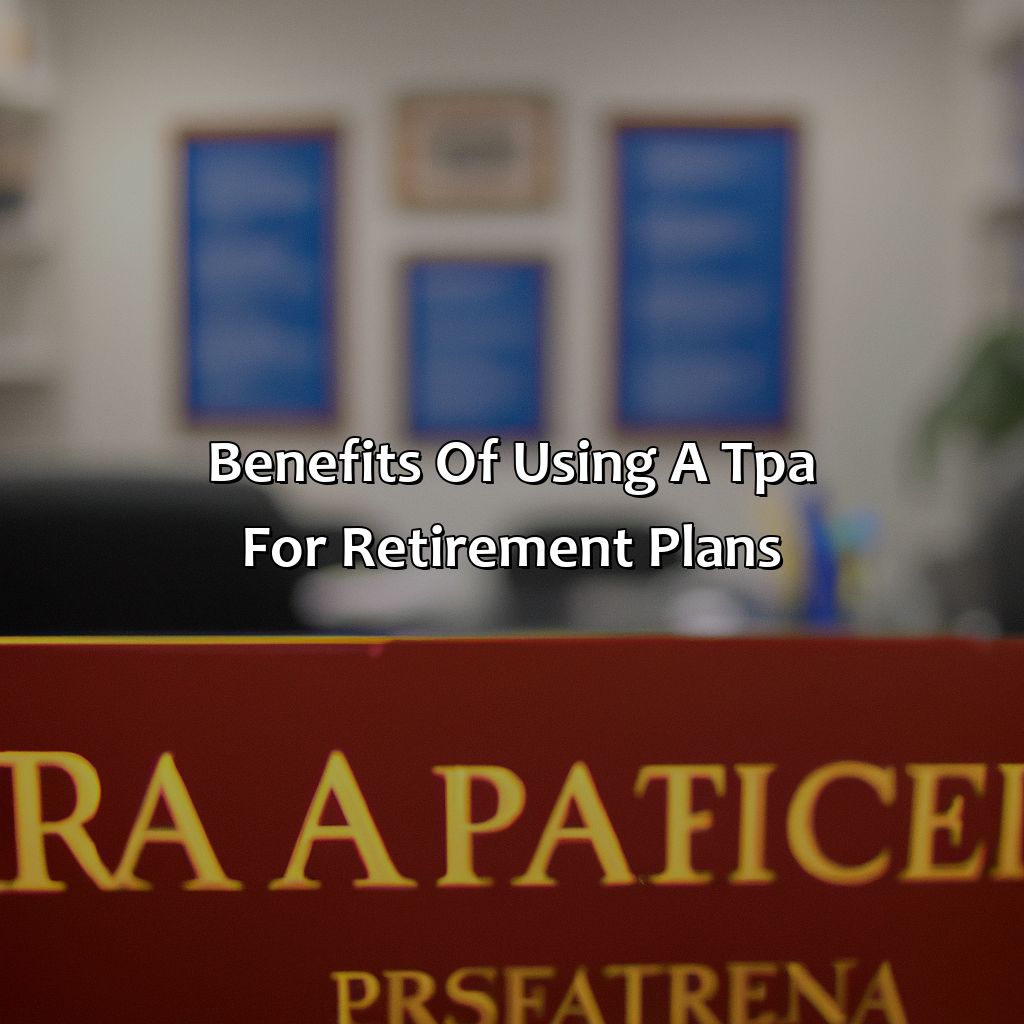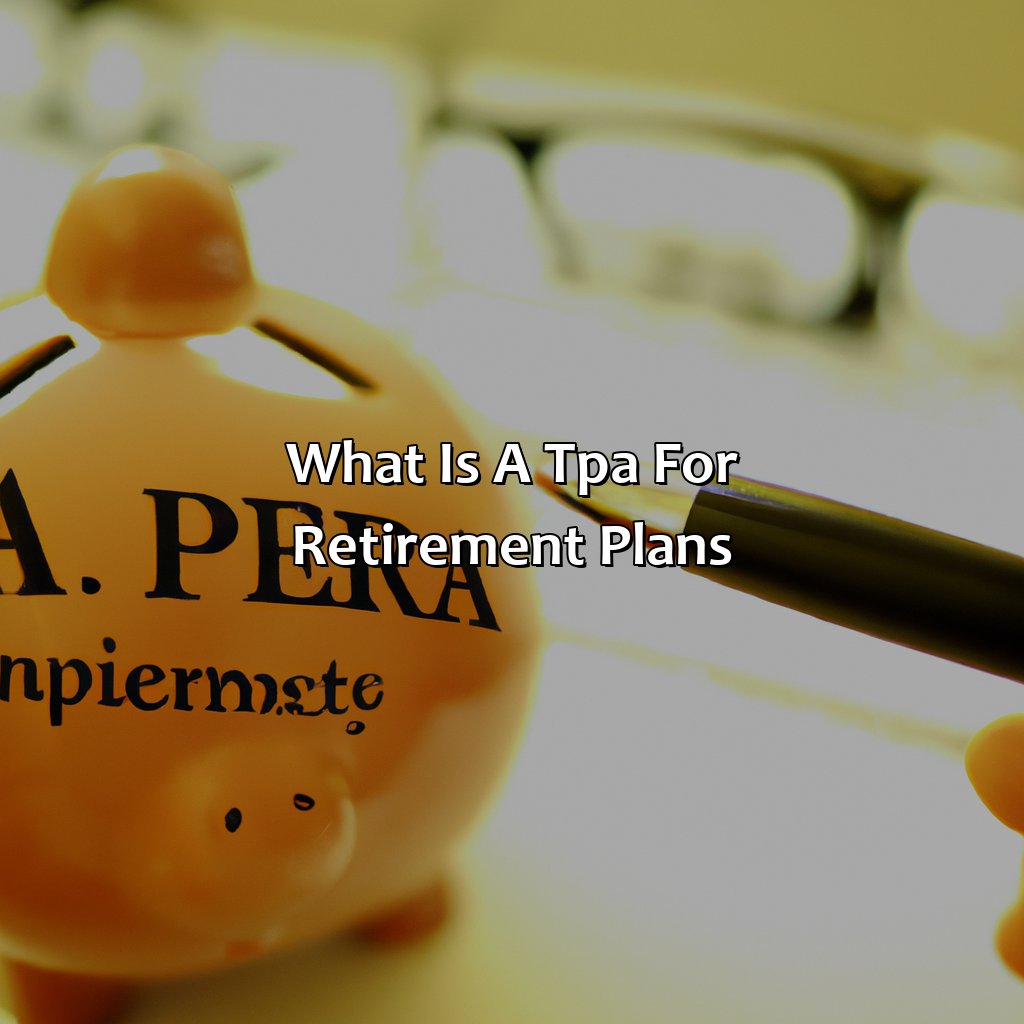What Is A Tpa For Retirement Plans?
Key Takeaway:
- A TPA, or Third-Party Administrator, is a company that provides administrative services for retirement plans, including recordkeeping, compliance testing, and tax reporting.
- The role of a TPA in retirement plans is to ensure that the plan is compliant with IRS regulations, calculate employer contributions and plan benefits, and provide support to plan sponsors and participants.
- Using a TPA for retirement plans can provide expertise in navigating complex regulations and compliance requirements, as well as cost-effectiveness by outsourcing administrative tasks to a specialized provider.
- When choosing a TPA for retirement plans, considerations should include expertise in plan design and compliance, experience with retirement plan administration, and availability of support and education for plan sponsors and participants.
Are you confused about the role of a third-party administrator (TPA) in your retirement plan? This article will help you understand what they do and the benefits they provide. Let’s get started to ensure your retirement plan is in the best shape possible. You won’t regret it!
What is a TPA for retirement plans?
Let’s explore each sub-section individually to understand the definition and role of a TPA (Third Party Administrator) for retirement plans.
The definition of TPA covers the general idea. Meanwhile, the role of a TPA in retirement plans outlines why it is key in administering such plans.

Image credits: retiregenz.com by Adam Washington
Definition of TPA
TPA, or Third Party Administrator, refers to a service provider that manages and administers retirement plans. TPAs typically work with employers and plan sponsors to ensure compliance with IRS regulations, establish eligibility requirements, manage contributions and distributions, calculate benefits and perform required testing. They may also assist with plan design, document preparation, and annual IRS filings. Overall, a TPA plays a critical role in promoting participant confidence and ensuring successful outcomes for retirement plans.
In addition to their administrative duties, TPAs also provide education and support to employers and participants. They can offer guidance on investment options, retirement planning strategies, and other financial considerations. Some TPAs even offer online resources or personalized consultations to help participants make informed decisions about their retirement goals.
While many retirement plans are managed in-house by larger companies or financial institutions, smaller organizations often turn to TPAs for cost-effective solutions. By outsourcing these duties to a dedicated service provider, employers can reduce administrative burdens while maintaining high levels of compliance and efficiency.
Don’t miss the opportunity to optimize your retirement plan! Employers who partner with a TPA gain access to expert guidance and customized solutions that can enhance employee satisfaction while maximizing benefits. Contact a TPA today to learn more about how they can help you achieve your retirement goals.
Without a TPA in retirement plans, it’s like trying to find a needle in a haystack while blindfolded and drunk.
Role of a TPA in retirement plans
A TPA serves as a vital component of retirement plans, overseeing compliance and administration. Their role runs the gamut from understanding federal regulations to determining the right plan for an organization’s needs. They work as third-party entities collaborating with employers to ensure objective guidance on plan design, preparation of annual returns, and compliance testing. This enables businesses to maintain top-level service that complies with regulations while being cost-efficient.
TPAs have in-depth knowledge about different plan types and help employers choose the most suitable one for their employees. Additionally, they handle various technical tasks such as processing contributions or loan requests, ensuring government filing deadlines are met for regulatory compliance. Moreover, TPAs also provide valuable expertise related to employee communications and investments education.
A reliable TPA advises organizations on provisions in the law that can impact their retirement plan significantly. For instance, a change in regulations might force an employer to amend its offering to conform or risk facing stiff penalties. It’s essential for companies to find a professional TPA that provides consistent support over time.
Pro Tip: Choosy employees want competitive salaries along with perks like 401(k) matching. An experienced TPA helps employers remain compliant while giving benefits that attract quality workers.
Using a TPA for retirement plans is like hiring a personal trainer for your finances – it’s worth the investment for the long-term benefits.
Benefits of using a TPA for retirement plans
Want to benefit from experienced direction and compliance? Using a TPA (Third Party Administrator) for retirement plans is the best way. Let’s look at the advantages, like expertise, rules-following, and cost savings.

Image credits: retiregenz.com by Harry Arnold
Expertise and compliance
Utilizing a third-party administrator (TPA) for retirement plans can provide necessary expertise and compliance. The TPA ensures that all plan documents and activities comply with current laws and regulations. Their expertise in navigating complex rules can result in cost savings, efficient reporting, and reduced risk. Additionally, TPAs can offer personalized support to employees, guiding them through investment options and explaining benefits.
Employers may benefit from working with a TPA that specializes in their specific industry or plan design. These professionals can offer unique insights and tailor services to fit the company’s needs. TPAs can also assist with plan testing, monitoring of contributions and distributions, annual audits, and submission of required filings with various regulatory bodies.
It is crucial for employers to ensure their TPA possesses sufficient experience, knowledge, certifications, and licenses before engaging their services. Employers should also inquire about the TPA’s fees structure as it may differ vastly between providers or based on the level of service provided. To maximize the benefits of working with a TPA for retirement plans, employers must develop a comprehensive communication strategy to educate their staff about the partnership’s advantages and answer questions about the well-being guarantees offered as part of the plan.
In summary, utilizing a specialized third-party administrator for retirement plans not only ensures compliance but also provides valuable expertise that helps cut costs while managing risks associated with noncompliance – resulting in long-term stability to both parties involved in this highly regulated process.
“Saving for retirement is like preparing for the apocalypse, and using a TPA is like hiring a doomsday prepper – cost-effective and ensures you’ll survive the financial aftermath.”
Cost-effectiveness
One benefit of utilizing a third-party administrator (TPA) for retirement plans is the potential cost-effectiveness compared to handling the administration in-house. A TPA can provide expertise and resources that may not be available internally, leading to more efficient and accurate plan administration. This can lead to potential cost savings for employers.
Additionally, outsourcing the administration to a TPA can help mitigate compliance risks, as TPAs are well-versed in regulatory requirements and can ensure that plans are being administered according to the latest rules and regulations. This can save companies from facing costly penalties or legal issues.
Furthermore, using a TPA for retirement plan administration allows for customization of plans based on the specific needs of the employer and employees. TPAs also offer personalized customer service, acting as a liaison between plan sponsors and participants.
According to Forbes’ “The Three Biggest Benefit Trends For 2021”, outsourcing plan administration is becoming increasingly popular among small-to-medium-sized businesses.
Choosing a TPA for retirement plans is like choosing a life partner – you want someone trustworthy, reliable, and who won’t leave you in financial despair.
How to choose a TPA for retirement plans
Choosing the optimum TPA for your retirement plan requires careful evaluation. To aid you in this process, we have created a “Considerations for Choosing a TPA” and an “Evaluating Potential TPAs” section. This will help you navigate the abundance of possibilities.

Image credits: retiregenz.com by Harry Jones
Considerations for choosing a TPA
When selecting a Third-Party Administrator (TPA) for retirement plans, there are critical considerations to be aware of. These factors can help decipher the best TPA for retirement plan management.
To make an informed decision when choosing a TPA, it is crucial to consider the following key aspects: experience and expertise, services offered, technology platforms utilized, reputation and pricing. A detailed table explaining these elements in-depth will assist in understanding each factor’s significance.
Considerations for Choosing a TPA:
| Key Factors | Description |
|---|---|
| Experience and Expertise | Evaluate the TPA’s years of experience & knowledge in managing retirement plans with complex compliance requirements |
| Services Offered | Verify the variety of services available, including plan design consulting, administration, record-keeping, communication with participants |
| Technology Platforms | Review different types of technological tools that TPAs use to manage their services, ensuring an appropriate suite for your business’ specific needs. |
| Reputation | Analyze customer feedback or reviews online or through personal networks on the vendor’s reliability in accurately and effectively administering 401k account management solutions. |
| Pricing | Investigate whether the costs associated are reasonable compared to other TPAs with similar features and benefits. |
It is essential to look at a potential TPA partner beyond just basic qualifications such as certifications but focus on unique characteristics that could impact your decision.
It is suggested that prospective clients should review profiles related to each criterion explicitly. It helps businesses comprehend what kind of partnership they can expect from a vendor based on individual business requirements.
Choosing the right fit requires due diligence on TPAs as they significantly impact regulatory compliance obligations as well as participant satisfaction levels. Thus it is critical to identify quality providers before engaging them in partnership agreement terms.
Choosing a TPA for your retirement plan is like picking a life partner – you want someone reliable, trustworthy, and able to handle your finances without screwing things up.
Evaluating potential TPAs
When looking for potential third party administrators (TPAs) for your retirement plan, it’s important to evaluate their experience and expertise in managing plans that are similar in size and structure. Additionally, consider their technology capabilities and responsiveness to communication.
Make sure the TPA is familiar with regulations such as ERISA and has a strong track record of compliance with deadlines and reporting requirements. Ask about the range of services they offer, including investment advice, plan design assistance, and employee education.
To ensure a successful partnership, inquire about their client retention rate and ability to resolve issues promptly. Remember that selecting a TPA is a long-term decision and requires careful consideration.
Pro Tip: Don’t be afraid to ask for references or testimonials from other clients who have worked with the TPA before. Their insight can give you valuable information about what to expect from the partnership.
Five Facts About What Is a TPA for Retirement Plans:
- ✅ TPA stands for Third-Party Administrator, and they administer retirement plans for employers. (Source: The Balance)
- ✅ TPAs handle administrative tasks and compliance issues associated with retirement plans, such as 401(k)s and pensions. (Source: Investopedia)
- ✅ TPAs work with employers to design and manage retirement plans that meet the needs of the company and its employees. (Source: Forbes)
- ✅ TPAs may provide investment advice to participants regarding their retirement plan options. (Source: IRS)
- ✅ TPAs must adhere to strict guidelines set by the Employee Retirement Income Security Act (ERISA) to ensure compliance and protect participants’ rights. (Source: Department of Labor)
FAQs about What Is A Tpa For Retirement Plans?
What is a TPA for retirement plans?
A TPA (Third Party Administrator) for retirement plans is a company that provides administrative services for employer-sponsored retirement plans. This includes plan design consultation, recordkeeping, compliance testing, and government reporting. TPAs work with plan sponsors to ensure the plan meets legal requirements and runs efficiently.
Why do I need a TPA for my retirement plan?
A TPA can help ensure that your retirement plan is compliant with federal regulations, which can be complex and time-consuming to navigate. TPAs also offer plan design consultation to help maximize the benefits for plan participants and minimize expenses for the plan sponsor.
How do I choose the right TPA for my retirement plan?
When choosing a TPA, consider the firm’s experience in the retirement plan industry, their level of customer service, and their reputation for compliance expertise. Additionally, you may want to consider the cost of their services and the level of customization available for your specific plan needs.
Can I hire a TPA if I already have a retirement plan in place?
Yes, you can hire a TPA even if you already have a retirement plan in place. A TPA can help you make changes to your existing plan or take over administrative duties from a current provider. Additionally, a TPA can provide ongoing support to ensure the plan continues to operate compliantly and effectively.
What is the difference between a TPA and a recordkeeper for a retirement plan?
A TPA and a recordkeeper both offer services for employer-sponsored retirement plans, but they have different responsibilities. A recordkeeper is responsible for the day-to-day operations of the plan, such as processing contributions and managing participant accounts. A TPA, on the other hand, has a broader scope of responsibility, including plan design consultation, compliance testing, and government reporting.
How much does it cost to hire a TPA for a retirement plan?
The cost of hiring a TPA for a retirement plan varies based on the size of the plan, the level of services needed, and the TPA’s fee structure. TPAs may charge a flat annual fee or a percentage of assets under management. It’s important to carefully review the fees and services offered by TPAs and compare them to other providers before making a decision.







